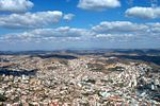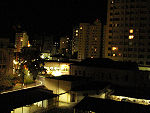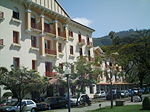
Poços de Caldas
Encyclopedia
Poços de Caldas is a city and municipality in south-western Minas Gerais
Minas Gerais
Minas Gerais is one of the 26 states of Brazil, of which it is the second most populous, the third richest, and the fourth largest in area. Minas Gerais is the Brazilian state with the largest number of Presidents of Brazil, the current one, Dilma Rousseff, being one of them. The capital is the...
state, Brazil, in the microregion of the same name. Its estimated population in 2009 was 151,449 inhabitants. The city has thermal waters.
Geography
It lies on the boundary of the state of São PauloSão Paulo
São Paulo is the largest city in Brazil, the largest city in the southern hemisphere and South America, and the world's seventh largest city by population. The metropolis is anchor to the São Paulo metropolitan area, ranked as the second-most populous metropolitan area in the Americas and among...
at 1186 meters elevation and is the main socio-economic nucleus of its region, having an area of 544 km² (85 km² urban and 459 km² rural) in the municipality.
The physical area is made up for the most part of a high plateau formed by mountains, fields and valleys with an area of approximately 750 km². The average elevation is 1200 m (3937 ft), with Cristo Redentor, the highest point, at 1686 m (5531 ft). The topography is highly suggestive of a volcanic
Volcano
2. Bedrock3. Conduit 4. Base5. Sill6. Dike7. Layers of ash emitted by the volcano8. Flank| 9. Layers of lava emitted by the volcano10. Throat11. Parasitic cone12. Lava flow13. Vent14. Crater15...
crater
Volcanic crater
A volcanic crater is a circular depression in the ground caused by volcanic activity. It is typically a basin, circular in form within which occurs a vent from which magma erupts as gases, lava, and ejecta. A crater can be of large dimensions, and sometimes of great depth...
and, given that the region's rocks are indeed igneous
Igneous rock
Igneous rock is one of the three main rock types, the others being sedimentary and metamorphic rock. Igneous rock is formed through the cooling and solidification of magma or lava...
and there are hot spring
Hot spring
A hot spring is a spring that is produced by the emergence of geothermally heated groundwater from the Earth's crust. There are geothermal hot springs in many locations all over the crust of the earth.-Definitions:...
s, this gave rise to a common misconception that Poços de Caldas would be located inside the crater of a large extinct volcano. In reality, Poços de Caldas is inside a caldera
Caldera
A caldera is a cauldron-like volcanic feature usually formed by the collapse of land following a volcanic eruption, such as the one at Yellowstone National Park in the US. They are sometimes confused with volcanic craters...
that was formed by the collapse of a central portion of terrain amid elevated areas, and while the latter have volcanic origin, the process that formed the supposed "crater" had nothing to do with volcanic activity.
Poços de Caldas occupies a highly strategic geographical location, due to its proximity to São Paulo (243 km), Belo Horizonte
Belo Horizonte
Belo Horizonte is the capital of and largest city in the state of Minas Gerais, located in the southeastern region of Brazil. It is the third largest metropolitan area in the country...
(460 km) and Rio de Janeiro
Rio de Janeiro
Rio de Janeiro , commonly referred to simply as Rio, is the capital city of the State of Rio de Janeiro, the second largest city of Brazil, and the third largest metropolitan area and agglomeration in South America, boasting approximately 6.3 million people within the city proper, making it the 6th...
(470 km), whose connections are made with good highways, and due to its integration into the routes of the hydro-mineral spas of Serra Negra
Serra Negra
-External links:...
, Águas de Lindóia
Águas de Lindóia
Águas de Lindóia is a Brazilian city of the state of São Paulo. It has a remarkable tourist activity due to its many water springs, being part of the "Circuito das Águas" . Close to it are the cities of Lindóia, Serra Negra and Monte Sião....
, Socorro, Monte Alegre do Sul, Águas da Prata, Caldas (Pocinhos do Rio Verde), Cambuquira
Cambuquira
Cambuquira is an Brazilian municipality of the State of Minas Gerais, Brazil.It has approximately 13,299 inhabitants , and the city is part of the Circuito das Águas of Minas Gerais.-History:...
, Lambari, Caxambu
Caxambu
Caxambu is a Brazilian city in Minas Gerais. Its population in 2004 was estimated at 23,482.Located at the Brazilian state of Minas Gerais, Caxambu is renowned by its spa, which has twelve sources of mineral water flowing, 24 hours a day....
and São Lourenço
São Lourenço, Minas Gerais
São Lourenço is a Brazilian town in the state of Minas Gerais, in the Southwest region of the country. It is one of the smallest Brazilian municipalities, with only 57.2 km² , and it is well known nationwide for its natural beauty and healing mineral waters...
. Poços de Caldas is also close to the most developed regions of the interior of the state of São Paulo, such as Ribeirão Preto
Ribeirão Preto
Ribeirão Preto is a municipality and city in the Northeastern region of the state of São Paulo in Brazil. It is nicknamed Brazilian California, because of a combination of an economy based on agrobusiness plus high technology, wealth and sunny weather all year long. With 605,114 inhabitants,...
(240 km), Campinas
Campinas
Campinas is a city and municipality located in the coastal interior of the state of São Paulo, Brazil. is the administrative center of the meso-region of the same name, with 3,783,597 inhabitants as of the 2010 Census, consisting of 49 cities....
(160 km) and São José dos Campos
São José dos Campos
São José dos Campos is a municipality and a major city in the state of São Paulo, Brazil and one of the most important industrial and research centers in Latin America. It is located in the Paraíba Valley, between the two most active production and consumption regions in the country, São Paulo ...
(315 km).

Climate
The climate is characterized by dry winters and mild summers. The winter is from April to September and has an average temperature of 15°C and rainfall of 315 mm. The summer is from October to March and has an average temperature of 21°C with rainfall of 1,430 mm. The annual rainfall is 1,745 mm. The average annual temperature is 17°C with minimums of -6°C and maximums of 31.7°C.
Economy
Known principally for its thermal baths, the city has resort hotels. The local soils are rich in minerals and yield thorium, zirconium, and bauxite, which is converted into aluminum there. The city has Brazil's first uranium-ore concentration plant, for use in the Angra I nuclear-power facility in Angra dos Reis.Poços is also the home of one of the largest bauxite
Bauxite
Bauxite is an aluminium ore and is the main source of aluminium. This form of rock consists mostly of the minerals gibbsite Al3, boehmite γ-AlO, and diaspore α-AlO, in a mixture with the two iron oxides goethite and hematite, the clay mineral kaolinite, and small amounts of anatase TiO2...
mines in the world belonging to Alcoa. http://www.alcoa.com/locations/brazil_pocos/en/home.asp Bauxite is an ore that contains at least 45% alumina, which is extracted to make aluminum.
The smelting operations at Pocos de Caldas have an annual capacity of 90,000 tons/year of primary aluminum. The facility is also the largest aluminum powder production facility in Latin America and the second largest in the world. The plant has a capacity of 14,000 tonnes/year of aluminum powder and meets the market demand for ferroalloys, refractories, pigments, metallurgy, chemicals, explosives and solid fuel for rockets. The facility began production of hydrated aluminas and hard-burned calcined aluminas in 1985.
Poços is also famous for its glass, which is known internationally. The founders of the factories were descendants of the artistic glassmakers who lived on the Island of Murano, near Venice, in Italy. In the city there are four glass factories: Ca'D'oro, São Marcos, Veneza and Bonora.
Due to its wealth in hydro-mineral resources, Poços de Caldas is also known for the quality of the soap that it produces. Some are almost handmade. There are four factories in the city: Raízes, Antares, Sarandi and Terra Brasil.
The city also gets most of its electricity from hydroeletric power plants, which were built and are administrated with local resources (DME), leading to an independence from the state's power system.
Tourism
The city is very well taken care of, with several green areas, among parks, squares, gardens and São Domingos mountain, which has trails for walking. The sulphurous water is the main attraction and can be consumed in several fountains and at the Thermas Antônio Carlos. There is an aerial tram to get to the Statue of Christ the Redeemer (1,686 mts.). At the top of the mountain there is a great view of the city and the nearby mountains. The city also offers options such as a Japanese tea garden, a theme park, museums, theaters, and other cultural events, the most important being the yearly Music in the Mountains Festival (Festival Musica nas Montanhas) http://www.festivalmusicanasmontanhas.com.brHistory
Poços was founded in 1872. The region had been inhabited by the Cataguases Indians, who had been expelled from their lands by the "Bandeiras Unidas Paulistas", during their quest for gold. The place was first called Freguesia de Nossa Senhora da Saúde das Águas de Caldas. In 1874 it became a district of Nossa Sra. da Saúde de Caldas, belonging to Caldas. In 1875 it was elevated to the category of city. This became famous after the discovery of the hot water, which could be used for curing disease, and many important people began to visit the spa in search of the cures provided by the water.The name comes from Caldas da Rainha
Caldas da Rainha
Caldas da Rainha is a city in western central Portugal. The city serves as the seat of the larger municipality of the same name and is the seat of the Comunidade Intermunicipal do Oeste...
, a spa town in central Portugal
Portugal
Portugal , officially the Portuguese Republic is a country situated in southwestern Europe on the Iberian Peninsula. Portugal is the westernmost country of Europe, and is bordered by the Atlantic Ocean to the West and South and by Spain to the North and East. The Atlantic archipelagos of the...
.

